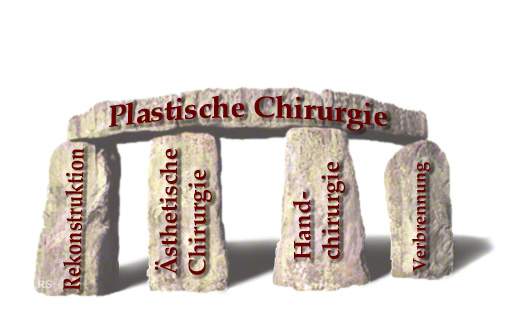
In principle, the descriptive term plastic surgery or plastic surgery must be distinguished from the specialist title (see below).
Plastic surgery and its four pillars
The plastic surgeon likes to see plastic surgery as a temple (see illustration) with four strong pillars. Each pillar stands for a focal point:
- Aesthetic plastic surgery adapts the body shape to the aesthetic needs of the patient.
- Reconstructive plastic surgery: The focus here is on restoring the body’s surface after defects caused by injury or tumor removal.
- Burn surgery is essentially part of the field of reconstructive plastic surgery. However, burn surgery is highly specialized, so that it deserves its own ‘pillar’.
- The hand surgery is a complex area in which a large part of the techniques available in plastic surgery are used.
The lexicon
The Brockhaus describes plastic surgery as a branch of surgery that aims to restore organic functions in the case of physical damage (congenital, injury-related) or to remove disfigurements through plastic surgery.
- It also describes constructive plastic surgery, which seeks to surgically reconstruct non-existent body parts.
- Reconstructive plastic surgery, on the other hand, refers to restoration.
- Anaplastic surgery deals with the topic of defect coverage. Defects caused by accidents or tumor removal are closed by tissue displacement or tissue transplantation.
- Cosmetic or aesthetic plastic surgery is described in a similar way to the temple model above.
What does plastic surgery mean?
The word plastic or plastic corresponds to the Greek plastikos and the Latin plasticus. It means: to form, shape; malleable, moldable… The word surgery is derived from the Greek ‘cheir’ and means hand. In this respect, plastic surgery is a shaping craft in the sense of the translation.
Specialist in plastic and aesthetic surgery
In order to obtain the title of specialist in plastic surgery, today: specialist in plastic and aesthetic surgery, at least six years of further training is required in accordance with the further training regulations. The new further training regulations (Common Trunk) were enacted by the medical associations in 2006. The further training regulations can be viewed by everyone on the homepages of the state medical associations.
The new training regulations for plastic surgery state the following:
- Basic further training: Two years must be completed with a person authorized to provide further training in surgery.
- A further year can be completed in any surgical specialty.
- A further three years must be completed with an authorized specialist in the field of plastic surgery.
What is cosmetic surgery?
Can cosmetic surgery be equated with the specialty of plastic surgery?
More on this question under cosmetic surgery.
What is a cosmetic surgeon?
Plastic surgery has its roots in India
Plastic surgery is still a young discipline in its own right. However, some of the surgical techniques used in this field today are quite old. The oldest descriptions can be found in ancient India.
The Indian physician Sushruta (also Susruta) describes in his work Susruta Samhita et al. various surgical techniques. His texts are said to have been written in the 6th century BC. However, opinions on this are not unanimous. The first of the five books contains a treatise on surgery and wound treatment. The special feature is the description of a nasal prosthesis for the reconstruction of the nose. This is a pedicled flap from the cheeks. This means that the skin was moved from the cheeks to the defect. The resulting skin-fat flap was supplied with blood via a stalk and allowed to heal. The field of plastic surgery was far from being born, but it was the first surviving plastic surgery technique.
The plastic surgeon with the Nobel Prize
In 1990, plastic surgeon Prof. Joseph E. Murray was awarded the Nobel Prize (Medicine or Physiology) for his life’s work in the field of kidney transplantation.

